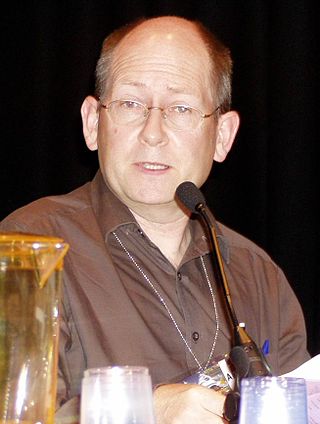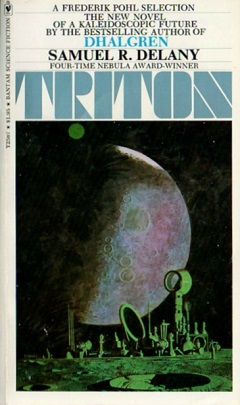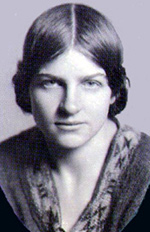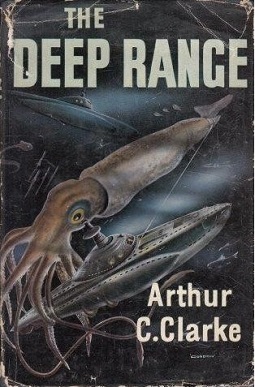
Joanna Russ was an American writer, academic and feminist. She is the author of a number of works of science fiction, fantasy and feminist literary criticism such as How to Suppress Women's Writing, as well as a contemporary novel, On Strike Against God, and one children's book, Kittatinny. She is best known for The Female Man, a novel combining utopian fiction and satire, and the story "When It Changed".
The New Wave was a science fiction (SF) style of the 1960s and 1970s, characterized by a great degree of experimentation with the form and content of stories, greater imitation of the styles of non-science fiction literature, and an emphasis on the psychological and social sciences as opposed to the physical sciences. New Wave authors often considered themselves as part of the modernist tradition of fiction, and the New Wave was conceived as a deliberate change from the traditions of the science fiction characteristic of pulp magazines, which many of the writers involved considered irrelevant or unambitious.

Stephen Baxter is an English hard science fiction author. He has degrees in mathematics and engineering.

Forgiveness, in a psychological sense, is the intentional and voluntary process by which one who may felt initially wronged, victimized, harmed or hurt goes through a process in changing feelings and attitude regarding a given offender for his/her actions, and overcomes the impact of the offense, flaw or mistake including negative emotions such as resentment or a desire for vengeance. Theorists differ in the extent to which they believe forgiveness also implies replacing the negative emotions with positive attitudes, or requires reconciliation with the offender. In certain legal contexts, forgiveness is a term for absolving someone of debt, loan, obligation, or other claims.

Foundation is a science fiction novel by American writer Isaac Asimov. It is the first published in his Foundation Trilogy. Foundation is a cycle of five interrelated short stories, first published as a single book by Gnome Press in 1951. Collectively they tell the early story of the Foundation, an institute founded by psychohistorian Hari Seldon to preserve the best of galactic civilization after the collapse of the Galactic Empire.

Trouble on Triton: An Ambiguous Heterotopia (1976) is a science fiction novel by American writer Samuel R. Delany. It was nominated for the 1976 Nebula Award for Best Novel, and was shortlisted for a retrospective James Tiptree, Jr. Award in 1995. It was originally published under the shorter title Triton.

Hawksbill Station is a science fiction novel by American writer Robert Silverberg. The novel is an expanded version of a short story first published in Galaxy Science Fiction in August 1967. The novel was published in 1968 and was released in the United Kingdom under the title The Anvil of Time.

The Female Man is a feminist science fiction novel by American writer Joanna Russ. It was originally written in 1970 and first published in 1975 by Bantam Books. Russ was an ardent feminist and challenged sexist views during the 1970s with her novels, short stories, and nonfiction works. These works include We Who Are About To..., "When It Changed", and What Are We Fighting For?: Sex, Race, Class, and the Future of Feminism.

Naomi Mary Margaret Mitchison, Baroness Mitchison was a Scottish novelist and poet. Often called a doyenne of Scottish literature, she wrote over 90 books of historical and science fiction, travel writing and autobiography. Her husband Dick Mitchison's life peerage in 1964 entitled her to call herself Lady Mitchison, but she never did. Her 1931 work, The Corn King and the Spring Queen, is seen by some as the prime 20th-century historical novel.
In Christian hamartiology, eternal sin, the unforgivable sin, unpardonable sin, or ultimate sin is the sin which will not be forgiven by God. One eternal or unforgivable sin, also known as the sin unto death, is specified in several passages of the Synoptic Gospels, including Mark 3:28–29, Matthew 12:31–32, and Luke 12:10, as well as other New Testament passages including Hebrews 6:4–6, Hebrews 10:26–31, and 1 John 5:16.

The Deep Range is a 1957 science fiction novel by British writer Arthur C. Clarke, concerning a future sub-mariner who works in the field of mariculture, herding whales. The story includes the capture of a sea monster similar to a kraken.
The Golden Age of Science Fiction, often identified in the United States as the years 1938–1946, was a period in which a number of foundational works of science fiction literature appeared. In the history of science fiction, the Golden Age follows the "pulp era" of the 1920s and 1930s, and precedes New Wave science fiction of the 1960s and 1970s. The 1950s are, in this scheme, a transitional period. Robert Silverberg, who came of age in the 1950s, saw that decade as the true Golden Age. According to historian Adam Roberts, "the phrase Golden Age valorises a particular sort of writing: 'Hard SF', linear narratives, heroes solving problems or countering threats in a space-opera or technological-adventure idiom."
The Xeelee Sequence is a series of hard science fiction novels, novellas, and short stories written by British science fiction author Stephen Baxter. The series spans billions of years of fictional history, centering on humanity's future expansion into the universe, its intergalactic war with an enigmatic and supremely powerful Kardashev Type IV alien civilization called the Xeelee, and the Xeelee's own cosmos-spanning war with dark matter entities called Photino Birds. The series features many other species and civilizations that play a prominent role, including the Squeem, the Qax, and the Silver Ghosts. Several stories in the Sequence also deal with humans and posthumans living in extreme conditions, such as at the heart of a neutron star (Flux), in a separate universe with considerably stronger gravity (Raft), and within eusocial hive societies (Coalescent).

Up the Line (1969) is a time travel novel by American science fiction author Robert Silverberg. The plot revolves mainly around the paradoxes brought about by time travel and is considered an example of the more sexually-permissive era of late 1960s American science-fiction, a reflection of the counterculture of its day. It was nominated for a Nebula Award for Best Novel in 1969 and a Hugo Award for Best Novel in 1970 but lost to Ursula K. Le Guin's The Left Hand of Darkness both times.

The Falling Torch is a 1959 science fiction novel by American writer Algis Budrys. A 1999 Baen Books edition was very slightly rewritten, and includes one entirely new chapter.

Windhaven is a science fiction fix-up novel by American writers George R. R. Martin and Lisa Tuttle. The novel is a collection of three novellas compiled and first published together in 1981 by Timescape Books. It was published as a mass market paperback in 1982 by Pocket Books. Both editions featured cover art by Vincent Di Fate. It was later reprinted by Bantam Spectra in hardcover in 2001, and paperback in 2003 and 2012, with cover art by Stephen Youll. The novel was also published in paperback form in the UK by New English Library in 1982 and Gollancz in 1988.

"Sidewise in Time" is a science fiction short story by American writer Murray Leinster that was first published in the June 1934 issue of Astounding Stories. "Sidewise in Time" served as the title story for Leinster's second story collection in 1950.

Samuel R. "Chip" Delany is an American writer and literary critic. His work includes fiction, memoir, criticism, and essays on science fiction, literature, sexuality, and society. His fiction includes Babel-17, The Einstein Intersection ; Hogg, Nova, Dhalgren, the Return to Nevèrÿon series, and Through the Valley of the Nest of Spiders. His nonfiction includes Times Square Red, Times Square Blue, About Writing, and eight books of essays. He has won four Nebula awards and two Hugo Awards, and he was inducted into the Science Fiction and Fantasy Hall of Fame in 2002.
The anthropologist Leon E. Stover says of science fiction's relationship to anthropology: "Anthropological science fiction enjoys the philosophical luxury of providing answers to the question "What is man?" while anthropology the science is still learning how to frame it". The editors of a collection of anthropological SF stories observed:
Anthropology is the science of man. It tells the story from ape-man to spaceman, attempting to describe in detail all the epochs of this continuing history. Writers of fiction, and in particular science fiction, peer over the anthropologists' shoulders as the discoveries are made, then utilize the material in fictional works. Where the scientist must speculate reservedly from known fact and make a small leap into the unknown, the writer is free to soar high on the wings of fancy.
"Souls" is a 1982 science fiction novella by Joanna Russ. It was first published in the Magazine of Fantasy & Science Fiction in January 1982, and subsequently republished in Terry Carr's The Best Science Fiction of the Year 12, in Russ's 1984 collection Extra(ordinary) People, as well as in the first volume of the Isaac Asimov/Martin H. Greenberg-edited anthology The New Hugo Winners, and in 1989 as half of a Tor Double Novel.














